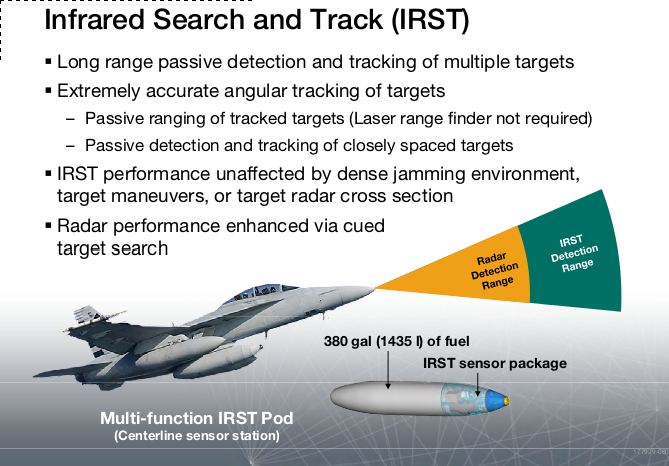
Posted on 12/10/2014 7:24:33 PM PST by sukhoi-30mki
The U.S. Navy received Milestone C acquisition approval earlier this month to begin low-rate initial production (LRIP) of an infrared search and track (IRST) sensor pod for the F/A-18 Super Hornet. Manufacturer Lockheed Martin and partner Boeing will deliver six pods in the first LRIP lot.
The AN/ASG-34 IRST sensor gives the F/A-18E/F a long-range, passive search and tracking capability against multiple targets, supplementing the jet’s APG-79 active electronically scanned radar and other sensors. The pod is mounted on the nose section of the Super Hornet’s centerline fuel tank. It completed a first flight aboard an F/A-18F in February.
“Integrating the infrared pod onto the Super Hornet revolutionizes how we fight on a networked battlefield,” said Capt. Frank Morley, Naval Air Systems Command PMA-265 program manager. “IRST advances the Super Hornet’s role in air-to-air combat operations, keeping us ahead of our adversaries in an evolving threat environment.”
The IRST program “was not impervious” to defense budget cuts, said Michele Moran, the PMA-265 electro-optics/infrared integrated product team lead. “Our team was able to completely restructure the program, overcome the budget constraints and press forward with Milestone C.”
Vice Adm. Paul Grosklags, principal military deputy to the assistant secretary of the Navy for research, development and acquisition made the Milestone C approval on December 2. The six LRIP pods will enable the program to work toward initial operational capability of the system, which the Navy expects in 2017.

Active Duty ping.
Now the pilot can’t eject the center line fuel tank when it is empty?
Obama will give orders for all center tanks to be dropped when empty. How else are the Ruskies, Chinese and Iranians going to get long-range passive detection technology?
What difference in range vs. the Russian IR stuff would be interesting.
~Obama will give orders for all center tanks to be dropped when empty. How else are the Ruskies, Chinese and Iranians going to get long-range passive detection technology?~
IRST technology might be new for F-18 but it is quite common on Flankers, which puts real combat effectiveness of radar-evading stealth aircraft in question.
Or when the pilot needs to engage in air combat maneuvering????
Of course he can.
He just swipes his credit card using the conveniently located cockpit reader. His account will be charged $18,000,000 and - once authorization is received - he can release the tank.
 There is room; I guess the USN doesn't want to spend time and money to integrate it directly to the airframe of serving aircraft.
There is room; I guess the USN doesn't want to spend time and money to integrate it directly to the airframe of serving aircraft.
 There is room; I guess the USN doesn't want to spend time and money to integrate it directly to the airframe of serving aircraft.
There is room; I guess the USN doesn't want to spend time and money to integrate it directly to the airframe of serving aircraft.
Oh, he can drop the tank, he’s just going to have some ‘spanin to do. Hey, he will get a nice greeting/thank you card from Lockheed.
That problem will be resolved with version-2. The pilot will be removed to make room for the integrated pod and the plane will be piloted remotely from the Harry Reid memorial drone center in Nevada.
“There is room; I guess the USN doesn’t want to spend time and money to integrate it directly to the airframe of serving aircraft.”
I suspect if they tried it, the NAVAIR required documentation would exceed the cost of the physical integration..........
military ping
*
Yes, it's a more expensive option and requires airframe modifications to retrofit, but if I got in a dog fight, It'd be the first thing to go!
IIRC, the F14 had its IR system integrated into the airframe, and it had longer range than the radar for detection and tracking. By now, these should be very mature systems.
Disclaimer: Opinions posted on Free Republic are those of the individual posters and do not necessarily represent the opinion of Free Republic or its management. All materials posted herein are protected by copyright law and the exemption for fair use of copyrighted works.